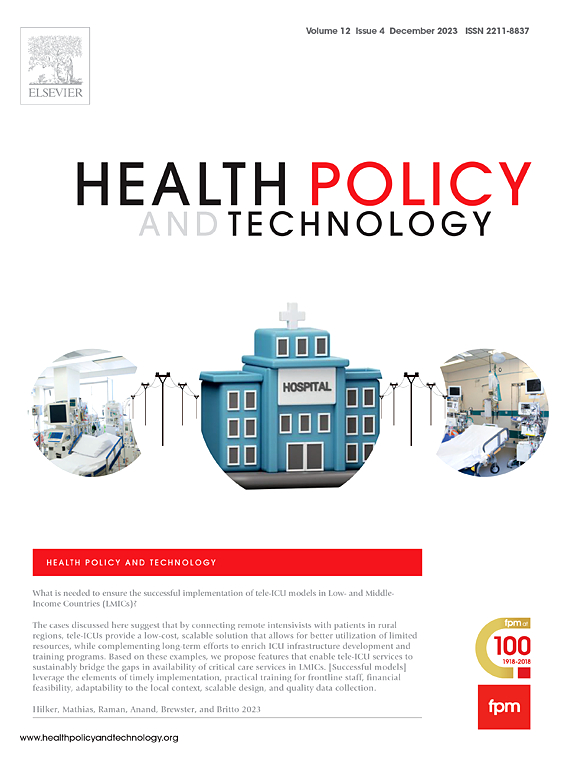美国医疗保健服务价格透明政策的结果:一项系统综述
IF 3.7
3区 医学
Q1 HEALTH POLICY & SERVICES
引用次数: 0
摘要
本系统综述评估了美国医疗服务价格透明度政策在影响价格可得性、价格意识和医疗成本方面的作用。方法:我们检索了5个数据库中评估美国价格透明度政策的英语研究;排除文献综述、透视、病例报告、非保健研究和非美国研究。两名调查人员独立进行了数据提取和质量评估。我们使用Cochrane和国家心肺血液研究所的工具检查了研究的偏倚风险和质量,定性地总结了研究结果,并定量地分析了纳入的研究。结果共纳入87项研究。医院价格透明度的规定在早期面临低遵守的问题。政府价格透明项目与降低某些服务价格增长有关,但许多项目缺乏付款人和提供者的综合定价数据。这些发现受到纳入研究质量低的限制。现有的价格透明政策似乎受到了很大的限制,尽管新出现的证据表明,它们有望改变价格增长和医疗保健利用。政策制定者应考虑修改价格透明度政策,使其更加稳健、准确和用户友好。在最近对87项科学研究的回顾中,我们调查了美国政策在使医疗保健价格清晰易懂方面的功效。尽管医院常常难以提供准确且易于使用的价格信息,但共享这些信息的政府项目帮助减缓了价格的上涨,并鼓励人们使用更实惠的医疗服务,尤其是医疗成像。随着医疗保健价格的不断上涨,我们的研究结果表明,设计得更好的政府计划可以帮助每个人都更清楚地了解价格,从而节省资金,帮助患者做出明智的决定。本文章由计算机程序翻译,如有差异,请以英文原文为准。
Outcomes of price transparency policies for healthcare services in the United States: A systematic review
Background
This systematic review evaluates the role of price transparency policies for healthcare services in influencing price availability, price awareness, and health costs in the US.
Methods
We searched five databases for English-language studies evaluating price transparency policies in the US; literature reviews, perspectives, case reports, non-healthcare studies, and non-US studies were excluded. Two investigators independently conducted data extraction and quality assessment. We examined study risk of bias and quality using Cochrane and National Heart, Lung, and Blood Institute tools, qualitatively summarized study findings, and quantitatively analyzed included studies.
Results
Eighty-seven studies were included. Hospital price transparency mandates faced early issues with low compliance. Government price transparency programs were associated with reduced price growth for some services, but many lacked comprehensive pricing data by payer and provider. These findings were limited by the low quality of included studies.
Conclusions
Existing price transparency policies appear subject to substantial limitations, although emerging evidence suggests that they hold promise for changing price growth and healthcare utilization. Policymakers should consider modifying price transparency policies to become more robust, accurate, and user-friendly.
Public Interest Summary
In a recent review of 87 scientific studies, we investigated the efficacy of US policies in making healthcare prices clear and accessible to the public. Although hospitals often struggled with providing accurate and easy-to-use price information, government programs that shared this information helped slow down the rise in prices and encouraged people to use more affordable healthcare, especially for medical imaging. As healthcare prices keep rising, our findings suggest that better-designed government programs could help make prices clearer for everyone, potentially saving money and helping patients make informed decisions.
求助全文
通过发布文献求助,成功后即可免费获取论文全文。
去求助
来源期刊

Health Policy and Technology
Medicine-Health Policy
CiteScore
9.20
自引率
3.30%
发文量
78
审稿时长
88 days
期刊介绍:
Health Policy and Technology (HPT), is the official journal of the Fellowship of Postgraduate Medicine (FPM), a cross-disciplinary journal, which focuses on past, present and future health policy and the role of technology in clinical and non-clinical national and international health environments.
HPT provides a further excellent way for the FPM to continue to make important national and international contributions to development of policy and practice within medicine and related disciplines. The aim of HPT is to publish relevant, timely and accessible articles and commentaries to support policy-makers, health professionals, health technology providers, patient groups and academia interested in health policy and technology.
Topics covered by HPT will include:
- Health technology, including drug discovery, diagnostics, medicines, devices, therapeutic delivery and eHealth systems
- Cross-national comparisons on health policy using evidence-based approaches
- National studies on health policy to determine the outcomes of technology-driven initiatives
- Cross-border eHealth including health tourism
- The digital divide in mobility, access and affordability of healthcare
- Health technology assessment (HTA) methods and tools for evaluating the effectiveness of clinical and non-clinical health technologies
- Health and eHealth indicators and benchmarks (measure/metrics) for understanding the adoption and diffusion of health technologies
- Health and eHealth models and frameworks to support policy-makers and other stakeholders in decision-making
- Stakeholder engagement with health technologies (clinical and patient/citizen buy-in)
- Regulation and health economics
 求助内容:
求助内容: 应助结果提醒方式:
应助结果提醒方式:


